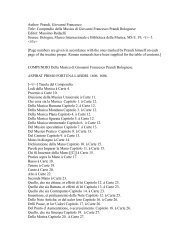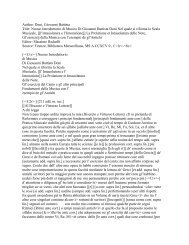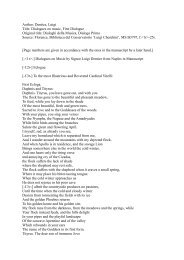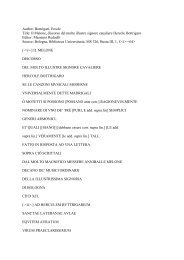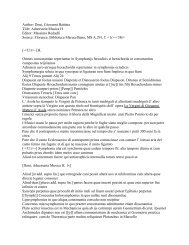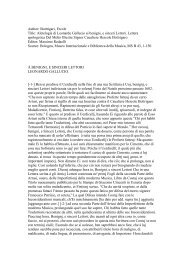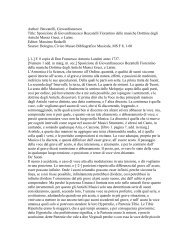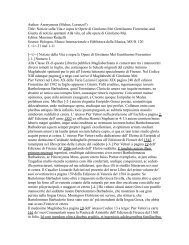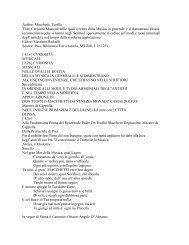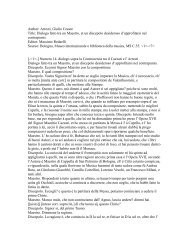Author: Doni, Giovanni Battista - manuscripts of italian music theory ...
Author: Doni, Giovanni Battista - manuscripts of italian music theory ...
Author: Doni, Giovanni Battista - manuscripts of italian music theory ...
You also want an ePaper? Increase the reach of your titles
YUMPU automatically turns print PDFs into web optimized ePapers that Google loves.
chiarascuro, as it is called, which is the same as calling it light and shadow, in the<br />
same way one cannot create a melody without this combination <strong>of</strong> intervals large and<br />
small which in the Diatonic and natural genus are the tones and the Semitones. This<br />
simile is so appropriate to express this propriety <strong>of</strong> <strong>music</strong> that the ancient painters, as<br />
Pliny teaches us, used this word <strong>of</strong> tone to denote that part <strong>of</strong> the colour which is<br />
[[that]] midway between light and dark. And one sees that it is established by nature<br />
with admirable order (which it is found in excellence in every part <strong>of</strong> <strong>music</strong>) that just<br />
as the first division <strong>of</strong> the octave is made into a fifth and a fourth (which almost as a<br />
perfect union <strong>of</strong> male and female form the matrimony <strong>of</strong> Harmony which contains<br />
everything, namely the eighth Diapason, to which [[is given this]] [--] one <strong>of</strong> the<br />
meanings <strong>of</strong> the word Harmony corresponds, thus also the progress <strong>of</strong> any song and<br />
melody is created with the same components <strong>of</strong> fourth and fifths placed in alternation.<br />
Because [[the octave]] the Diapente spans a whole Diatessaron and a tone (always<br />
intending, unless stated otherwise the sesquiottavo and larger which was the only one<br />
know in the most ancient times) and, consequently, the Diapente embraces two<br />
Diatessara and a Tone, it was rightly called the tone <strong>of</strong> the disjunction or division to<br />
distinguish it from the others which are put as integral parts <strong>of</strong> the two Diatessara.<br />
This was done because it separates at the same time the same fourths [[albeit it<br />
unites]] and unites them within the consonance <strong>of</strong> an octave. Now, we understand that<br />
this separation occurs when an intervals is interposed between two others, which do<br />
not have a common term, but each one has its own, as from one can see in these<br />
examples<br />
[<strong>Doni</strong>, On the Genera and the Modes, 20]<br />
In the first <strong>of</strong> them the note a la mi re unites two fourths, since it is a common term<br />
between both <strong>of</strong> them, so that the two extreme sound a seventh. In the second then<br />
the tone which intervenes between a la mi re and [sqb] mi separates and divides the<br />
two fourths, namely, the lower one E A, and the higher one [sqb] e, so that their<br />
highest and lowest notes answer each other [--] at the distance <strong>of</strong> an octave.<br />
Therefore, it follows that, since the ancients found this order perfectly, one sees in any<br />
kind <strong>of</strong> melody that nature abhors to continue for more than three tones because <strong>of</strong> the<br />
great harshness that they would create and the juxtaposition <strong>of</strong> two Semitones. This in<br />
nature does not happen, because, equally nature refuses that subtle tenderness which<br />
they caused. The ancient established their large Diatonic System on two octaves<br />
[[and]] and, consequently, on two fifths and two fourths, and they gave the same<br />
name [names ante corr.] to [[the notes]] each note which has the note that sounds that<br />
sound. Therefore one must imagine that this system is nothing else but a disposition<br />
<strong>of</strong> fifteen strings in an instrument which would have been so disposed according to<br />
the adjacent intervals which are sung in the Diatonic. Therefore, they divided all the<br />
large System into four Tetrachords (namely four smaller systems <strong>of</strong> four strings or<br />
notes each) and two Tones which are used for the mention Disjunction and for the<br />
creation <strong>of</strong> the fifths and the completion <strong>of</strong> the octaves. However, one must note<br />
already that, albeit [[in their authors what sort]] the modern authors commonly<br />
maintain that [[Salinas Zarlino in the second part <strong>of</strong> the Institutioni <strong>music</strong>ali chapter<br />
50 in marg.]] our Scale or perfect System is divided in hexachords because <strong>of</strong> the<br />
choice <strong>of</strong> those six notes Ut Re mi fa sol la and then they contrast and compare those<br />
hexachords with the ancient Tetrachords [--] as Salinas does apart from Zarlino



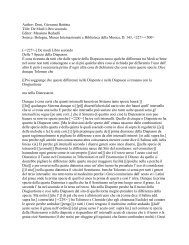
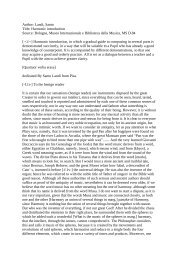
![Doni, Giovanni Battista Title: Trattato Dei Tuoni o [[Harmonie de]]](https://img.yumpu.com/45461005/1/190x245/doni-giovanni-battista-title-trattato-dei-tuoni-o-harmonie-de.jpg?quality=85)
